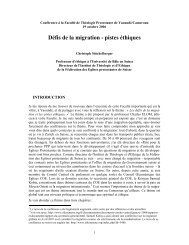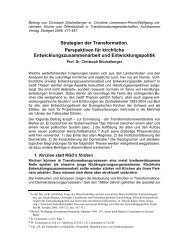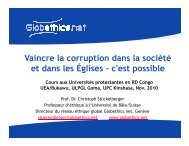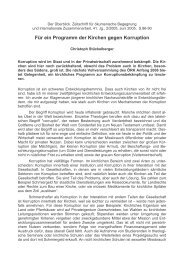BREAK THE CHAINS OF OPPRESION AND THE YOKE OF ...
BREAK THE CHAINS OF OPPRESION AND THE YOKE OF ...
BREAK THE CHAINS OF OPPRESION AND THE YOKE OF ...
You also want an ePaper? Increase the reach of your titles
YUMPU automatically turns print PDFs into web optimized ePapers that Google loves.
The scientific understanding of climate change<br />
In this theological context, we approach the current scientific understandings of<br />
recent and future changes in the earth’s climate. In the second half of the twentieth<br />
century it was recognised that ‘global atmospheric concentrations of CO , 2<br />
methane (CH4 ) and nitrous oxide (N20) have increased markedly as a result of<br />
human activities since 1750 and now far exceed pre-industrial values determined<br />
from ice cores spanning many thousands of years’ 3 – carbon dioxide levels being<br />
around 30% higher than pre-industrial values by the year 2000. The Intergovernmental<br />
Panel on Climate Change (IPCC) is tasked with drawing together observations<br />
and climate modelling studies, together with assessing potential impacts<br />
of future climate change resulting from human activity. After over 15 years<br />
of concerted research, the fourth report of the IPCC published in 2007 concluded<br />
that ‘Warming of the climate system is unequivocal’ 4 and that ‘Most of the<br />
observed increase in global-averaged temperatures since the mid-20th century is<br />
very likely due to the observed increase in anthropogenic [human induced]<br />
GHG [greenhouse gas] concentrations.’ 5 In predicting future climatic changes,<br />
the IPCC set out several scenarios, projecting temperature rises by the end of the<br />
21st century ranging from just under 2°C (compared to the end of the 20th century)<br />
for a gradual reduction in GHG emissions after 2040, to 4°C for continuing<br />
increasing GHG emissions. 6<br />
Associated with these global temperature increases, the IPCC also judges climate<br />
change will cause:<br />
– increased frequency of heat waves over most land areas (very likely);<br />
– increased occurrence of heavy precipitation events over wet areas (very likely);<br />
– increased tropical cyclone activity (likely);<br />
– decreases in �water �availability � and droughts �in semi-arid � areas (high confi-<br />
dence);<br />
FuturE – the North Pole to be ice free in summer months by 2050, although recent<br />
trends in decreasing ice coverage have been faster than model predictions,<br />
suggesting that the rate of climate change, at least in some areas is faster<br />
than projected; 7<br />
– gradual sea level rise of seven metres over a timescale of 1000 years, although<br />
‘more rapid sea-level rise on century timescales cannot be excluded’,<br />
affecting ‘major changes in coast lines and inundation of … river deltas<br />
and low lying islands’. 8<br />
3 IPCC, ‘Summary for Policymakers of the Synthesis Report of the IPCC Fourth Assessment’,<br />
(2007), 5.<br />
4 IPCC, ‘Synthesis Report Summary’, 2.<br />
5 IPCC, ‘Synthesis Report Summary’, 5.<br />
6 IPCC, ‘Synthesis Report Summary’, 7–8, Figure SPM-5 and Table SPM-1.<br />
7 IPCC, ‘Synthesis Report Summary’, 13, Table SPM-3.<br />
8 IPCC, ‘Synthesis Report Summary’, 13.<br />
������������������������������������������������<br />
� � � � ������������������������<br />
�<br />
150<br />
– Hope in God’s Future –










